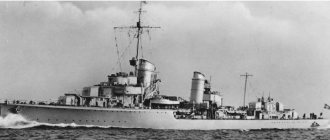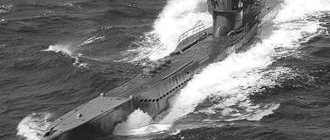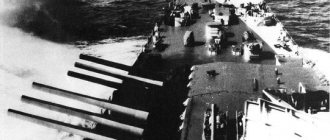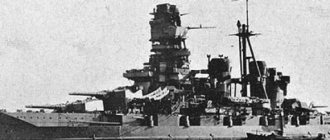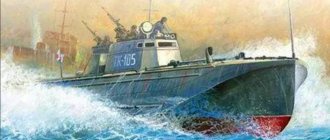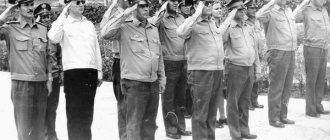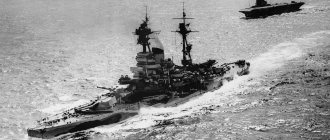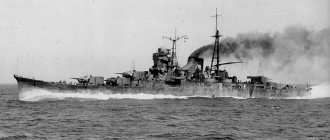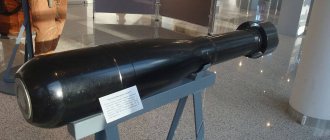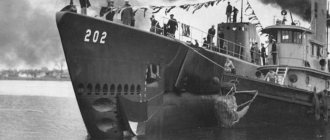Destroyers and torpedo boats | Japan
Destroyer "Minekaze"
Destroyer Akikaze
Destroyer Yukaze
The Minekaze-class destroyer series consisted of 15 units (Minekaze, Sawakaze, Okikaze, Shimakaze, Nadakaze, Yаkaze, Hаkaze, Shiokaze, Akikaze, Yukaze, Tachikaze, Hokaze, Nokaze, Namikaze, Numakaze), built at the Maizuru Naval Arsenal shipyards. , "Mitsubishi-Nagasaki" and put into operation in 1920-1922. The destroyers Shimakaze and Nadakaze were reclassified as patrol ships in 1940 and were lost in 1943 and 1945. Nine ships were lost in 1943-1945. "Yukaze" and "Namikaze" were transferred to Great Britain and China in 1947 due to reparations. The remaining ships were decommissioned in 1947-1948. Performance characteristics of the ship: standard displacement - 1.3 thousand tons, full displacement - 1.7 thousand tons; length – 97.5 m, width – 9 m; draft - 2.9 m; speed – 34 – 36 knots; power plants - 2 steam turbine units and 4 steam boilers; power – 38.5 thousand hp; fuel reserve - 300 tons of oil; cruising range - 3 thousand miles; crew - 148 people. Armament: 2x1 - 120 mm guns; 2x2 – 533 mm torpedo tubes; 10-16x1 – 25 mm anti-aircraft guns; bomb releaser, 4 onboard bomb launchers; 36 depth charges.
Destroyer Hayate
Destroyer Yunagi
Series of Destroyer-class destroyers “Kamikaze” - 9 units (“Kamikaze”, “Asakaze”, “Harukaze”, “Matsukaze”, “Hatakaze”, “Oite”, “Hayate”, “Asanagi”, “Yunagi”), built at the shipyards "Maizuru Naval Arsenal", "Mitsubishi-Nagasaki", "Uraga Dock Company", "Ishikawajima Shipyards", "Fujinagata Shipyards", "Sasebo Naval Arsenal" and commissioned in 1922-1925. In 1941-1942 the ships underwent rearmament. The destroyers Kamikaze and Harukaze were decommissioned in 1947. The remaining ships were lost in 1941-1945. Performance characteristics of the ship: standard displacement - 1.3 thousand tons, full displacement - 1.7 thousand tons; length – 97.5 m, width – 9.2 m; draft - 2.9 m; speed - 37 knots; power plants - 2 steam turbine units and 4 steam boilers; power – 38.5 thousand hp; fuel reserve - 420 tons of oil; cruising range - 4 thousand miles; crew - 148 people. Armament: 3x1 - 120 mm guns; 7-10x1 – 25 mm anti-aircraft guns; 4x1 – 13.2 mm machine gun; 2x2 – 533 mm torpedo tubes; 4 airborne bomb launchers; 48 depth charges.
Destroyer Nagatsuki
Destroyer Kisaragi
Destroyer Uzuki
Destroyer "Yūzuki"
The Mutsuki-class destroyer series consisted of 12 units (Mutsuki, Kisaragi, Yayoi, Uzuki, Satsuki, Minazuki, Fumizuki, Nagatsuki, Kikuzuki, Mikazuki ", "Mochizuki", "Yūzuki"), built at the shipyards "Maizuru Naval Arsenal", "Mitsubishi-Nagasaki", "Uraga Dock Company", "Ishikawajima Shipyards", "Fujinagata Shipyards", "Sasebo Naval Arsenal" and delivered to construction in 1925-1927 All ships were lost in 1942-1944. Performance characteristics of the ship: standard displacement - 1.3 thousand tons, full displacement - 1.8 thousand tons; length – 97.5 m, width – 9.2 m; draft – 3 m; speed - 37 knots; power plants - 2 steam turbine units and 4 steam boilers; power – 38.5 thousand hp; fuel reserve - 420 tons of oil; cruising range - 4 thousand miles; crew – 150 people. Armament: 4x1 - 120 mm guns; 1x2 – 25 mm anti-aircraft gun; 4x1 – 13.2 mm machine gun; 2x3 – 610 mm torpedo tubes; 2 onboard bomb launchers; 88 depth charges.
Destroyer "Ayanami"
Destroyer "Fubuki"
Destroyer "Amagiri"
Destroyer "Ikazuchi"
The Fubuki-class destroyer series consisted of three groups built at the Maizuru Naval Arsenal, Yokohama Shipyards, Fujinagata Shipyards, Uraga Dock Company, Sasebo Naval Arsenal, and Ishikawajima Shipyards. The first group “Fubuki” included 9 units (“Fubuki”, “Shirayuki”, “Hatsuyuki”, “Miyuki”, “Murakumo”, “Shinonome”, “Usugumo”, “Shirakumo”, “Isonami”, “Uranami”) , commissioned in 1928-1929. All ships were lost in 1942-1944. The second group "Ayanami" included 10 units ("Ayanami", "Shikinami", "Asagiri", "Yūgiri", "Amagiri", "Sagiri", "Oboro", "Akebono", "Sazanami", "Ushio") , put into operation in 1929-1932. The destroyer Ushio was decommissioned in 1948, the remaining ships were lost in 1941-1945. Performance characteristics of ships of the first and second groups: standard displacement - 2.1 thousand tons, full displacement - 2.6 thousand tons; length – 112 m, width – 10.4 m; draft – 3.2 m; speed - 34 knots; power plants - 2 steam turbine units and 4 steam boilers; power – 50 thousand hp; fuel reserve - 475 tons of oil; cruising range - 4.7 thousand miles; crew – 250 people. Armament: 2x2 - 127 mm guns; 4x3 and 1x2 - 25 mm anti-aircraft gun; 3x3 – 610 mm torpedo tubes; 2 onboard bomb launchers; 14 depth charges; 18 min. The third group “Akatsuki” included 4 units (“Akatsuki”, “Inazuma”, “Ikazuchi”, “Hibiki”) commissioned in 1932-1933. The destroyer Hibiki was decommissioned in 1947, the remaining ships were lost in 1942-1944. Performance characteristics of ships of the third group: standard displacement - 2.1 thousand tons, full displacement - 2.6 thousand tons; length – 106.7 m, width – 10.4 m; draft – 3.3 m; speed – 38 knots; power plants - 2 steam turbine units and 3 steam boilers; power – 50 thousand hp; fuel reserve - 475 tons of oil; cruising range - 5 thousand miles; crew - 220 people. Armament: 2x2 - 127 mm guns; 4x3 and 7x2 – 25 mm anti-aircraft gun; 3x3 – 610 mm torpedo tubes; 4 airborne bomb launchers; 36 depth charges; 18 min.
Destroyer Ariake
Destroyer Nenohi
The Hatsuharu-class destroyer series consisted of 6 units (Hatsuharu, Nenohi, Wakaba, Hatsushimo, Ariake, Yugure), built at the Sasebo Naval Arsenal, Uraga Dock Company shipyards ", "Kawasaki Kobe Shipyard", "Maizuru Naval Arsenal" and commissioned in 1933-1935. All ships were lost in 1942-1945. Performance characteristics of the ship: standard displacement - 1.7 thousand tons, full displacement - 2.2 thousand tons; length – 103.5 m, width – 10 m; draft – 3 m; speed - 37 knots; power plants - 2 steam turbine units and 3 steam boilers; power – 42 thousand hp; fuel reserve - 500 tons of oil; cruising range - 6 thousand miles; crew – 200 people. Armament: 2x2 - 127 mm guns; 6-10x2 – 25 mm anti-aircraft guns; 4x1 - 13.2 mm machine gun; 2x3 – 610 mm torpedo tubes; 4 airborne bomb launchers; 36 depth charges.
Destroyer Yamakaze
Destroyer Umikaze
The Shiratsuyu-class destroyer series consisted of 10 units (Shiratsuyu, Shigure, Murasame, Yudachi, Samidare, Harusame, Yamakaze, Kawakaze, Umikaze, Suzukaze "), built at the shipyards "Sasebo Naval Arsenal", "Uraga Dock Company", "Fujinagata Shipyards", "Maizuru Naval Arsenal" and commissioned in 1936-1937. All ships were lost in 1942-1945. Performance characteristics of the ship: standard displacement - 1.7 thousand tons, full displacement - 2.1 thousand tons; length – 103.5 m, width – 10 m; draft – 3.5 m; speed - 34 knots; power plants - 2 steam turbine units and 3 steam boilers; power – 42 thousand hp; fuel reserve - 500 tons of oil; cruising range - 6 thousand miles; crew - 180 people. Armament: 2x2 - 127 mm guns; 6-10x2 – 25 mm anti-aircraft gun; 4x1-13.2 mm machine gun; 2x3 – 610 mm torpedo tube; 4 airborne bomb launchers; 36 depth charges.
Destroyer "Asagumo"
The Asashio class destroyer series consisted of 10 units (Asashio, Ōshio, Asagumo, Michishio, Arashio, Natsugumo, Yamagumo, Minegumo, Asagumo, Arare ", "Kasumi"), built at the shipyards "Maizuru Naval Arsenal", "Fujinagata Shipyards", "Kawasaki-Kobe", "Sasebo Naval Arsenal", "Uraga Dock Company" and commissioned in 1937-1939. All ships were lost in 1942-1945. Performance characteristics of the ship: standard displacement - 2 thousand tons, full displacement - 2.6 thousand tons; length – 111 m, width – 10.4 m; draft – 3.7 m; speed – 35 knots; power plants - 2 steam turbine units and 3 steam boilers; power – 50 thousand hp; fuel reserve - 500 tons of oil; cruising range - 5.7 thousand miles; crew – 200 people. Armament: 3x2 - 127 mm guns; 14x2 – 25 mm anti-aircraft guns; 4x1-13.2 mm machine gun; 2x4 – 610 mm torpedo tubes; 4 airborne bomb launchers; 36 depth charges.
Destroyer Yukikaze
Destroyer "Amatsukaze"
Destroyer Nowaki
Destroyer Hagikaze
The Kagero-class destroyer series consisted of 18 units (Kagero, Shiranui, Kurohio, Oyashio, Hayashio, Natsushio, Hatsukaze, Yukikaze, Amatsukaze, Tokitsukaze, "Urakaze", "Isokaze", "Hamakaze", "Tanikaze", "Nowaki", "Arashi", "Hagikaze", "Maikaze"), built at the Maizuru Naval Arsenal, Uraga Dock Company, Fujinagata shipyards Shipbuilding Yard", "Kōbe-Kawasaki Shipbuilding Yard", "Sasebo Naval Arsenal" and commissioned in 1939-1941. The destroyer Yukikaze was transferred to China as reparations in 1947 and decommissioned in 1970. The remaining ships were lost in 1942-1945. Performance characteristics of the ship: standard displacement - 2 thousand tons, full displacement - 2.6 thousand tons; length – 111 m, width – 10.8 m; draft - 3.8 m; speed – 35 knots; power plants - 2 steam turbine units and 3 steam boilers; power – 52 thousand hp; fuel reserve - 500 tons of oil; cruising range - 5 thousand miles; crew – 240 people. Armament: 3x2 - 127 mm guns; 4-7x2 or 14x1 – 25 mm anti-aircraft guns; 4x1-13.2 mm machine gun; 2x4 – 610 mm torpedo tubes; 4 airborne bomb launchers; 36 depth charges.
Destroyer Naganami
Destroyer Hayanami
Destroyer "Akishimo"
The Yugumo-class destroyer series consisted of 20 units (Akigumo, Yugumo, Makikumo, Kazagumo, Naganami, Makinami, Takanami, Ōnami, Kiyonami, Tamanami) , "Suzunami", "Fujinami", "Hayanami", "Hamanami", "Okinami", "Kishinami", "Asashimo", "Hayashimo", "Akishimo", "Kiyoshimo"), built at the Maizuru Naval Arsenal shipyards , Uraga Dock Company, Fujinagata Shipbuilding Yard and commissioned in 1941-1944. All ships were lost in 1942-1944. Performance characteristics of the ship: standard displacement - 2.1 thousand tons, full displacement - 2.7 thousand tons; length – 111.6 m, width – 10.8 m; draft - 3.8 m; speed – 35 knots; power plants - 2 steam turbine units and 3 steam boilers; power – 52 thousand hp; fuel reserve - 500 tons of oil; cruising range - 5 thousand miles; crew - 228 people. Armament: 3x2 or 2x2 - 127 mm guns; 3x2 or 2x2 and 12x1 – 25 mm anti-aircraft guns; 4x1 - 13.2 mm machine gun; 2x4 – 610 mm torpedo tubes; 4 airborne bomb launchers; 36 depth charges.
Destroyer "Akizuki"
Destroyer Teruzuki
The Akizuki-class destroyer series consisted of 7 units (Akizuki, Teruzuki, Suzutsuki, Hatsuzuki, Niizuki, Wakatsuki, Shimotsuki), built at the Maizuru Naval Arsenal shipyards, Sasebo Naval Arsenal", "Mitsubishi Heavy Industries", "Uraga Dock Company" and commissioned in 1942-1944. The destroyer Wakatsuki was decommissioned in 1945, and Suzutsuki in 1948. The remaining ships were lost in 1943-1944. Performance characteristics of the ship: standard displacement - 2.7 thousand tons, full displacement - 3.7 thousand tons; length – 126 m, width – 11.6 m; draft – 4.2 m; speed - 33 knots; power plants - 2 steam turbine units and 3 steam boilers; power – 52 thousand hp; fuel reserve - 1097 tons of oil; cruising range - 8.3 thousand miles; crew – 300 people. Armament: 4x2 - 100 mm guns; 2x2 or 3-5x3 and 12x1 – 25 mm anti-aircraft guns; 4x1 - 13.2 mm machine gun; 1x4 – 610 mm torpedo tube; 6 airborne bomb launchers; 72 depth charges.
Destroyer Harutsuki
Destroyer "Natsuzuki"
The destroyers Fuyutsuki, Yoizuki, Harutsuki and Natsuzuki were a simplified group of Akizuki-class destroyers. They were built at the Maizuru Naval Arsenal, Sasebo Naval Arsenal, and Uraga Dock Company shipyards and were commissioned in 1944-1945. The destroyer Fuyutsuki was decommissioned in 1945, Yoizuki was transferred to China as reparations in 1947, Harutsuki to the USSR, and Natsuzuki to Great Britain.
Destroyer Yoizuki
Performance characteristics of the ship: standard displacement - 2.7 thousand tons, full displacement - 3.7 thousand tons; length – 126 m, width – 11.6 m; draft – 4.2 m; speed - 33 knots; power plants - 2 steam turbine units and 4 steam boilers; power – 52 thousand hp; fuel reserve - 1097 tons of oil; cruising range - 8.3 thousand miles; crew – 300 people. Armament: 4x2 - 100 mm guns; 7x3 and 30x1 – 25 mm anti-aircraft guns; 3x1 - 13.2 mm machine gun; 2x4 – 610 mm torpedo tubes; 6 airborne bomb launchers; 72 depth charges.
Destroyer "Tsuga"
The Momi-class destroyers "Tsuga", "Kuri" and "Hasu" were built at the shipyards "Ishikawajima Shipbuilding & Engineering", "Kure Naval Arsenal", "Uraga Dock Company" and commissioned in 1920-1922. “Tsuga”, “Kuri” died in 1945, and “Hasu” was decommissioned in 1946. Performance characteristics of the ship: standard displacement - 0.9 thousand tons, full displacement - 1.2 thousand tons; length – 83.6 m, width – 8 m; draft – 2.4 m; speed - 36 knots; power plants - 2 steam turbine units and 2 steam boilers; power – 21.5 thousand hp; fuel reserve - 275 tons of oil; cruising range - 3 thousand miles; crew - 110 people. Armament: 3x1 - 120 mm guns; 2 machine guns; 2x2 – 533 mm torpedo tubes; 4 airborne bomb launchers; 36 depth charges.
Destroyer "Kuretake"
The series of destroyers of the "Wakatake" type consisted of 6 units ("Wakatake", "Kuretake", "Asagao", "Fuyō", "Karukaya", "Sanae"), built on the lines of "Kawasaki Shipyards", "Maizuru Naval Arsenal", "Uraga Dock Company", "Ishikawajima Shipyards", "Fujinagata Shipyards" and commissioned in 1922-1923. In 1938, the ships underwent modernization. The destroyer Asagao was decommissioned in 1948. The remaining ships were lost in 1944-1945. Performance characteristics of the ship: standard displacement - 0.9 thousand tons, full displacement - 1.2 thousand tons; length – 83.6 m, width – 8 m; draft – 2.4 m; speed - 36 knots; power plants - 2 steam turbine units and 2 steam boilers; power – 21.5 thousand hp; fuel reserve - 275 tons of oil; cruising range - 3 thousand miles; crew - 110 people. Armament: 2x1 - 120 mm guns; 2x3 – 25-mm anti-aircraft guns; 4x1 – 13.2 mm machine gun; 4 airborne bomb launchers; 48 depth charges.
Destroyer "Chidori"
The Chidori-class destroyer series consisted of 4 units (Tomozuru, Chidori, Manazuru, Hatsukari), built at the Maizuru, Fujinagata shipyards and commissioned in 1933-1934. The destroyer "Chidori" was lost in 1944, "Tomozuru" and "Manazuru" were lost in 1945, "Hatsukari" was decommissioned in 1946. Performance characteristics of the ship: standard displacement - 535 tons, full displacement - 815 tons; length – 77.5 m, width – 7.4 m; draft – 2.5 m; speed – 28 knots; power plants - 2 steam turbine units and 2 steam boilers; power – 110 thousand hp; fuel reserve - 150 tons of oil; cruising range - 9 thousand miles; crew - 113 people. Armament: 2x1 - 120 mm guns; 2x2 and 6x1 – 25 mm anti-aircraft guns; 1x2 – 533 mm torpedo tube; 4 airborne bomb launchers; 48 depth charges.
Destroyer "Kiji"
The Otori-class destroyer series consisted of 8 units (“Otori”, “Hiyodori”, “Hayabusa”, “Kasasagi”, “Kiji”, “Kari”, “Sagi”, “Hato”), built at the Maizuru Naval shipyards Arsenal", "Tōkyō-Ishikawajima Shipbuilding Yard", "Yokohama Dock", "Ōsaka Iron Works", "Mitsui Engineering & Shipbuilding", "Harima Shipbuilding Yard" and commissioned in 1936 - 1937. The destroyer "Kiji" was transferred to the USSR in 1947 as reparations. The remaining ships were lost in 1943-1945. Performance characteristics of the ship: standard displacement – 840 tons, full displacement – 1,040 tons; length – 85 m, width – 8.2 m; draft – 2.8 m; speed - 30.5 knots; power plants - 2 steam turbine units and 2 steam boilers; power – 19 thousand hp; fuel reserve - 150 tons of oil; cruising range - 4 thousand miles; crew - 129 people. Armament: 2x1 - 120 mm guns; 1x1 – 40 mm, 3x2 and 5x1 – 25 mm anti-aircraft guns; 1x3 – 533 mm torpedo tube; 2 onboard bomb launchers; 48 depth charges.
Escort destroyer "Momi"
Escort destroyers of the "Matsu" type - 18 units ("Hinoki", "Kaede", "Kashi", "Kaya", "Keyaki", "Kiri", "Kuwa", "Maki", "Matsu", "Momi", "Momo", "Nara", "Sakura", "Sugi", "Take", "Tsubaki", "Ume", "Yanagi"), built at the Maizuru Naval Arsenal, Yokosuka Naval Arsenal, Fujinagata shipyards Shipbuilding Yard", "Kōbe-Kawasaki Shipbuilding Yard" and commissioned in 1944-1945. Six destroyers were lost in 1944-1945. In 1947, as reparations, the destroyers Kiri and Kaya were transferred to the USSR, and Kaede and Sugi to China. The remaining ships were scrapped in 1947-1948. Performance characteristics of the ship: standard displacement - 1.3 thousand tons, full displacement - 1.7 thousand tons; length – 92.2 m, width – 9.4 m; draft – 3.3 m; speed – 28 knots; power plants - 2 steam turbine units and 2 steam boilers; power – 19 thousand hp; fuel reserve - 370 tons of oil; cruising range - 4.7 thousand miles; crew - 211 people. Armament: 1x2 and 1x1 - 127 mm gun; 4x3 and 12x1 – 25 mm anti-aircraft guns; 1x4 – 610 mm torpedo tube; 2 bomb releasers; 2 onboard bomb launchers; 36 depth charges.
Escort destroyer "Hatsuzakura"
A series of simplified escort destroyers of the Matsu class was designated the Tachibana class, consisting of 14 units (Enoki, Hagi, Hatsuyume, Hatsuzakura, Kaba, Kaki, Kusunoki, Nashi ", "Nire", "Odake", "Shii", "Sumire", "Tachibana", "Tsuta", built at the Maizuru NY, Yokosuka NY, Fujinagata SB, Kawasaki Kobe shipyards and commissioned commissioned in 1945. The destroyers "Nashi" and "Tachibana" were lost in 1945. In 1947, the destroyers "Hatsuyume" and "Tsuta" were transferred to China as reparations, and "Shii" and "Hatsuzakura" were transferred to the USSR. The remaining ships were decommissioned in 1947-1948. Performance characteristics of the ship: standard displacement - 1.3 thousand tons, gross displacement - 1.6 thousand tons; length - 98 m, width - 9.3 m; draft - 3.4 m; speed - 29 knots; power plants - 2 steam turbine units and 2 steam boilers; power - 19 thousand hp; fuel reserve - 370 tons of oil; cruising range - 4.6 thousand miles; crew - 211 people. Armament: 1x2 and 1x1 - 127 mm gun; 4x3 and 12x1 - 25 mm anti-aircraft guns; 1x4 - 610 mm torpedo tube; 7 onboard bomb throwers;
60 depth charges. Share to:
Everyone is looking for "Hiryu"
Six months later, a completely different story happened. This happened on June 5, 1942, on the second day of the Battle of Midway. Early in the morning, Japanese destroyers removed the crew from the burning Hiryu, the last of the four aircraft carriers of the Mobile Force, after which they hit it with a pair of torpedoes and left.
However, a Japanese plane arriving a couple of hours later discovered that the Hiryu was still afloat. In addition, he noticed forgotten crew members on deck. The destroyer Tanikaze was sent to the aircraft carrier that did not want to sink.
The Americans were also interested in what happened to the fourth Japanese aircraft carrier. In the end, Rear Admiral Spruance despaired of understanding anything from the conflicting messages from the Catalinas and decided to simply send dive bombers there. So as not to get up twice - all the remaining ones.
A photograph of the burning Hiryu taken on the morning of June 5, 1942 by a reconnaissance aircraft from the aircraft carrier Hosho.
In total, this amounted to 32 “dontless” from the Enterprise and Yorktown, plus the same number from the Hornet. But the aircraft carriers did not know that a couple of groups of “flying fortresses” were also sent from Midway for the same purpose.
